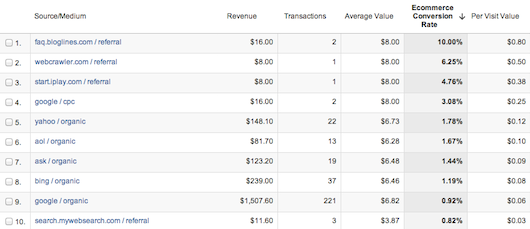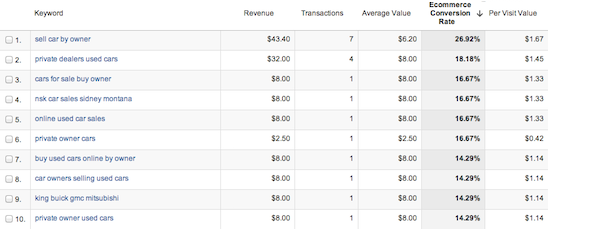Who Are These People Visiting My Website?
This is part 3 of a multi-part series on increasing conversions from your website traffic. If you haven’t already, you should read part one, which introduces the Infinite Conversion Loop. And Part Two which gets your Analytics in order.

Now that you have high confidence in your Analytics, let’s discuss the next step of the Infinite Conversion Loop, identifying your visitors. The first thing to understand when you are trying to improve your conversion rate is that not all visitors are created equal, which is why simply looking at your overall traffic numbers is an empty metric.
On any site you are going to have a wide variety of visitors that all want and expect different things. Here’s just an example of a few of the types of people you may see if you run a website for used car shopping, but these same type of people exist for many sites.
The Cast
- Mr. Shotgun – This guy isn’t great at searching, just average. If he wants to buy a new 2012 Audi A6 with leather, his query is probably just “audi”. Then he clicks on the first search result he gets without reading, hits back, clicks the next one, hits back, until he finds something that kind of meets his expectations. These are the people that end up on page 5 of Google result and kill your bounce rate if you don’t have a clear message.
- Miss Untargeted – This is the visitor you get from Reddit, Hacker News, Drudge Report, etc… when you post a great blog. They give you that big awesome spike in traffic that never seems to result in increased conversions. They make you feel good about your traffic numbers, but really they have no intention of converting on your website. They also make your site-wide conversion numbers useless, and cause Sys Admins to pull their hair out.
- Mr. Confused – This person is running IE6, unpatched, he’s looking for exactly what your website sells, but can’t figure out how to find it on your site, and when he does he don’t trust you because you don’t have the Visa or BBB logo.
- Señor Advanced – This person found your website with a query like: used -new acura tl -reviews “low mileage”. Your website is exactly what they’d want, but your refinements don’t let him find what he’s looking for in an efficient way so he leaves.
- Mrs. Researcher – She got to you by clicking your ad, she’s looking for what your site sells, and she even finds product she wants, but wants to make sure she gets the best price, so she’ll bookmark your site for now while she looks at some other sites.
- Botman 9000 – Some percentage of your traffic will be bots, spammers, or others who have no intention of using your website like a real person, let alone buying something. While the bots won’t usually show up in your analytics, they will often submit forms and do other things that makes your “back end” numbers never quite match up with the Analytics numbers.
This cast are the reason your overall visits mean nothing. These people represent the 98% of people you get daily but are not converting. I could give you a million hits today, but if they are the people in this group, you’ll see $0 out of it. The key to improving conversions is first getting a handle on what type of visitors are likely to convert in the first place, and then optimizing your site to convert those that are not converting now for some reason (some of the above have the potential, but your website has deficiencies that prevent them from doing so).
The Numbers
So first, let’s figure out who IS converting on your site. The first thing I would look at is your landing pages report, ordered by visitors. Specifically the Bounce Rate (The percentage of people that visited that single page then left).

What do these stats mean? First, these are from a profile I use that broadly groups types of content into single URLs. This site has over one million URLs, and I find most useful to categorize everything into types of pages (you can do this with filtered profiles in GA, which is probably the topic of another post). You can see the Index page of the site is how most people are entering by far. 22% bounce immediately, meaning something about the home page felt completely wrong for whatever those people were looking for. We’ll examine how to improve that number in future posts. You’ll notice a few popular blog posts have much higher bounce rates. These are the “Miss Untargeted” that are coming to your site for one-off content, but are probably not interested in buying whatever you are selling. It is interesting to note that one blog only has a bounce rate of 50%, indicating there is something about that post that invites people to dig further into your site.
Next I would look at the Exit rate (The percentage of people that left on a given page). The Exit rate is useful for identifying common pages that people are leaving your site on. This often points to problems on the page or shows you that people are not finding what they want (for example if a search result page is a common exit point). I order this report by Exit rate, filtering out outliers first.

Next look at where your most valuable traffic is coming from. I would do this by going to Sources->All Traffic, clicking ECommerce at the top, and then sorting by Ecommerce conversion rate. In this case, once you take out a few outliers, it looks like search engines (both paid and organic) are giving us the most valuable traffic. Another case of how blogs, social networks, etc… will increase overall traffic but not necessarily contribute to the bottom line (these things may be valuable for SEO though, so I’m not saying don’t do it, just don’t focus on overall traffic numbers as a KPI)

Of course it’s very difficult to read people’s intentions just by looking at numbers. The only real way we can try to find their intent is by looking at what they searched for to get to us (hurry before the number of logged in Google users increases!). Create a report of Organic Search Traffic ordered by Ecommerce conversion rate to see what terms are the most valuable. You’ll usually see some good long tail keywords you never would have considered. I would also sort by 0% conversions to see the keywords you may be wasting your time with. Remember to normalize these results by filtering to see keywords with at least 10 visits or so.

Those are some beginner ways of segmenting users or figuring out what they are trying to do on your site, some proactive ways to segment is the use of Custom Variables. Most people use these to track “logged in users” or what affiliate someone came from, but what about tracking those people who found no search results? That’s what I did here, and there is no surprise there is $0 revenue from those users… perhaps an opportunity to use spelling correction or show similar products.

Using Custom Variables is a great way to create segments of content and visitors to determine easily what types of users, content, etc… leads to the best conversions.
Hopefully using these tips will get you started in figuring out where your traffic is coming from, the next post in the Infinite Conversion Loop series will delve deeper into actually seeing what people are doing on your website.